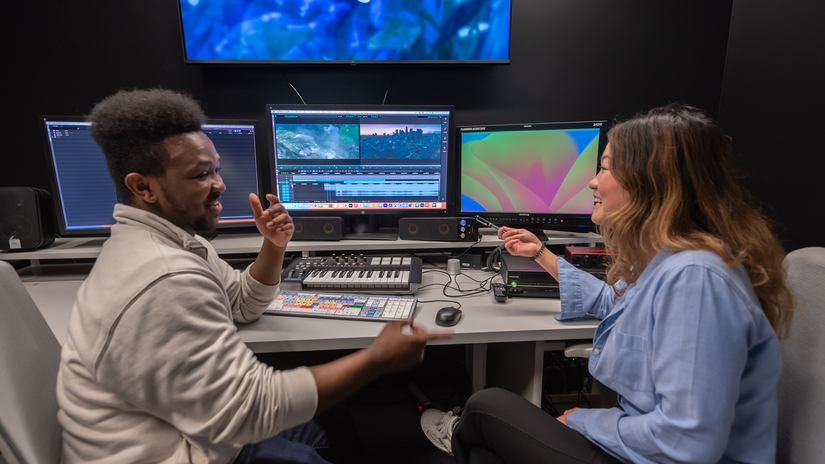ARC 30 | Studio 3: Architecture3 unitsTransfer: CSU
An architectural studio course which focuses on an understanding of how environment and building systems informs architectural concepts. This course explores questions of concept, sustainability, culture, and social responsibility within the context of buildings which are responsive to the environment and people utilizing them. Students will also give visual and oral presentations which are used in the development of a course portfolio. |
|---|---|
ARC 31 | Design Communication 33 unitsTransfer: CSU Formerly INTARC 38. Develop advanced skills in two-dimensional and three-dimensional digital drafting and rendering for Interior and Architectural designers. |
ARC 32 | Construction Materials and Methods3 unitsTransfer: CSU
A comprehensive look at how a building is put together, the systems it contains, and the methods of construction for different building types and construction materials in context with code requirements and sustainability. |
ARC 40 | Studio 4: Architecture3 unitsTransfer: CSU
An architectural studio course which provides a creative framework to explore the development of commercial and mixed-use buildings within an urban setting. Urban sites are analyzed in terms of community, culture, economics, and sustainability. Projects balance structural, environmental, social, and programmatic strategies. Visual and oral presentations are used in the development of a course portfolio. |
ARC 41 | Design Communication 43 unitsTransfer: CSU
Formerly INTARC 70. This is a studio course in 3D Computer Rendering and Animation. It will cover advanced computer applications in a virtual interior with an emphasis on lighting, textures, and camera angles. Students will create walk-throughs and digital 3D visual representations of interior spaces. |
ARC 45 | Designing Spaces: Enhancing the Human Experience3 unitsTransfer: CSU In this course, we will explore how architecture and design research intersect with immersive and augmented reality, enriching the design process. Students will delve into fundamental principles of spatial design and strategies for creating spaces augmented with interactive and storytelling elements. Using real world projects, students will develop the competencies needed to create multi-modal, user-centric spatial experiences. |
ARC 51 | Design Communication 53 unitsTransfer: CSU Formerly INTARC 65. Digitally build and enhance images for professional presentations through the exploration of materials, light, color, texture, and shadows. Emphasis is placed on producing realistic images for professional interior and architectural design work. |
ARC 70 | Portfolio2 unitsTransfer: CSU
A look at the importance of portfolios in the design field, the different types of portfolios, and how to create visually cohesive project pages. Students design and build a digital portfolio which can be used for transfer to a university, to apply for employment, or to showcase professional work. |
ARC 88A | Independent Studies in Architecture1 unitTransfer: CSU Please see “Independent Studies” section. |
ARC 88B | Independent Studies in Architecture2 unitsTransfer: CSU Please see “Independent Studies” section. |
ARC 88C | Independent Studies in Architecture3 unitsTransfer: CSU Please see “Independent Studies” section. |
ARC 90A | Architecture Internship1 unitTransfer: CSU Please see “Internships” section. |
ARC 90B | Architecture Internship2 unitsTransfer: CSU Please see “Internships” section. |
ARC 90C | Architecture Internship3 unitsTransfer: CSU Please see “Internships” section. |
ART 10A | Design I3 unitsTransfer: UC, CSU This is an introductory course in the theory and application of the elements of 2-D design. Assignments will focus on the following design principles: line, value, form, scale, light, logic, space, depth, texture, pattern, composition and color theory. This course is required for all art majors. |
ART 10B | Design Theory & Practice3 unitsTransfer: UC, CSU This studio course focuses on research based design principles and their application in real world scenarios. Critical design thinking is considered in the context of the arts, mass media, social sciences, ecology, architecture, and interactive systems. |
ART 10C | Digital Media3 unitsTransfer: UC, CSU
This course is a continuation of the theory and application of the principles and elements of fine art and design on the computer. Introducing the basics of computer operation for digital imaging applications, scanner technologies, and learning how to apply visual design concepts with digital media. This course serves as preparation for further study in the computer arts by providing an overview of theoretical issues related to the use of computers in fine art disciplines. Studio projects focus on integrating visual design principles with digital imaging technology and personal expression. |
ART 13 | Form and Space: Introduction to 3D Design3 unitsTransfer: UC, CSU C-ID: ARTS 101. This course is an introduction to historical references, conceptual ideas, and hands on applications related to three-dimensional design. Students in this class will look at spatial composition, along with organizing principles and elements of design as they apply to space and form. Students are invited to experiment with new materials, cutting edge technology, and critical dialogues in order to develop their own visual vocabulary for creative expression. The class will have regular lectures, practices with work space organization for exhibitions, and a sense of play in the use of materials for non-representational three-dimensional studio projects. This course is spirited and experimental. |
ART 15 | Lettering3 unitsTransfer: CSU
This course covers calligraphy, including hand-written letter forms and type faces, styles, proportion, lay-out and spacing as applied in personal correspondence, advertising, layout and brochures. |
ART 17A | 3D Jewelry Design I3 unitsTransfer: CSU
This course explores jewelry design and silversmithing as an art form and includes both fabricating and lost-wax casting techniques. |




